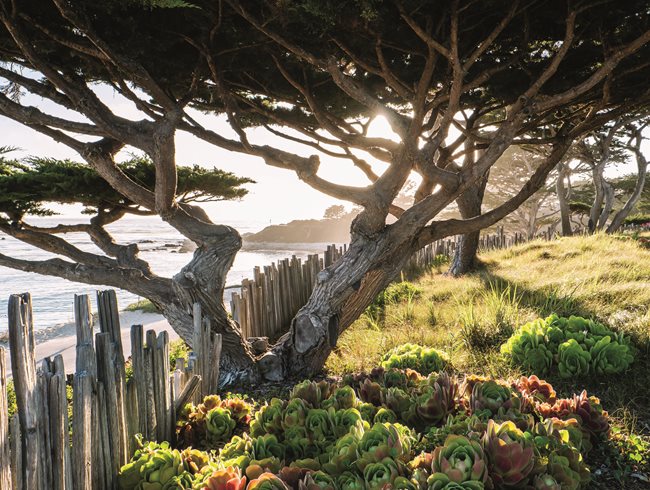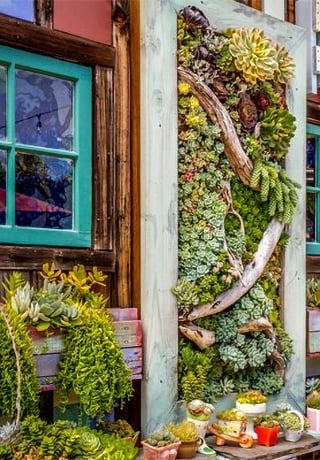Q&A with the Succulent Guy
Robin Stockwell, aka “The Succulent Guy” shares his tips for succulent success.For more than 30 years, Robin Stockwell of The Succulent Guy has been promoting succulents and showing off their beauty. As he says in the introduction to his book Succulents, “If you present [succulents] well, you will show off their unique beauty to the fullest.”
We chatted with Stockwell about all things succulents, including his tips for success.

In his book Succulents, Robin Stockwell shows a plethora of ways succulents can be displayed. “Aeoniums and aloes make great accents among fine-textured grasses,” Stockwell writes. “They look a little ghostlike when settled among grasses that sway in the breeze. Photo by: Tom Story.
Garden Design: How did you fall in love with succulents?
Robin Stockwell: I studied political science in college and intended to go into international relations. Somewhere along the way I was captivated by succulents. I started growing them in college fresh out of the army. Then I started helping a friend grow plants on my days off and ended up becoming partners with him when we bought a cactus collection.
Initially I was intrigued by the fact that retail nurseries didn’t have succulents, and I was interested in how we could put together a product line that would work for retailers. It was the business side of succulents that first got me interested.
Back in the 1970s people just weren’t using succulents in landscapes. As I learned more about the plants and saw how they could be used I began to really appreciate the beauty of the plants themselves. It was evolutionary.
GD: What are some of your best tips for designing with succulents?
RS: I think the number one thing is to not be intimidated by them. It’s OK to make mistakes—succulents are quite forgiving. You can pull them out and move them or cut off the tops and replant them. Each time you’d learn something new about how the plants grow in a space and what plants you like best.
I also like that succulents have a very diverse set of shapes, colors, and sizes to work with. This means there’s something for every style and size of garden. But, when you find succulents you like and that fit your space don’t use a lot of different varieties. Just pick a few to work with and use a lot of them in large sweeps and groupings.
Lastly, there are succulents for wide range of growing conditions. There are succulents for shade, light shade, filtered sun, full sun, salty air, sand. Usually, as long as there’s good drainage and the other plants around them don’t have to be watered all the time you’ll be OK.
GD: Do you have any tips for growing succulents and being successful with them?
RS: Succulents like decent drainage. So if you have soil where drainage is bad (clay for example) the easiest things to do is to mound your soil in order to raise it 4 to 6 inches.
If you are able to replace your soil or if you’re adding soil to a new planting bed I recommend a general purpose landscape blend that you can get from a local nursery or bulk materials supplier. Just make sure it’s a blend that doesn’t get too hot (you don’t want too much nitrogen). It’s a good idea to amend the soil with pumice which helps with drainage.
To do a 6- by 40-foot planting I would lay the soil down and put the pumice amendment on top then rototill it in. After that you’ll be ready to plant.
If you’re planting a smaller space or a container you can use a standard bagged cactus mix, but I recommend amending it with pumice, pearlite, or crushed lava. Use the ratio of 1 part amendment to 4 parts soil.
GD: What are some tricks you’ve learned to make succulents look their best in the garden?
RS: I’m a backpacker and I like to hike in the mountains. I’ve always said that succulents have a face (think big rosettes on Aeonium) and that you should think about which direction their face is looking when you’re planting them. Don’t plant them all with their face looking straight up at the sky. You want them looking all different directions.
One of the best ways to create a dynamic succulent planting is to use large boulders and rocks. You can tuck succulents in and round the boulders or let them creep over the top. When you plant succulents next to rocks, plant them at an angle. They will look more natural and attractive. The angle will enhance both the aesthetics of the rock and the succulent.
GD: What are some of the common pitfalls when growing succulents?
RS: One of the most common questions I get questions is what succulents should I plant in the shade? The key to success with succulents in the shade is to not watering them too much. I recommend plants such as Aeonium canariense, Agave attenuata, and Echeveria imbricata. Other succulents can be used but oftentimes to get their normal coloration, they need sun.
GD: When you’re doing a mass planting how do you know how many plants to use?
RS: With large plantings I have a general guideline that says a plant in a 2-inch container will fill a 6-inch space in about 1 year. A plant in a 4-inch container will fill an 8-inch space in about 1 year. If you plant succulents closer together with equal spacing between each plant they will fill in pretty quickly. The space will look good for several years but be ready to thin and replants your succulent cuttings in 3 to 5 years (this helps keep the plants looking good).
GD: Anything else you like to tell people about succulents?
RS: Many succulents have the most incredible flowers. And many (aloes, for example) bloom during the winter when little else is in bloom. And many succulents also attract hummingbirds to the garden. Some of my favorites are tree aloes such as Aloe ferox and A. speciose. But even low-growing succulents like Echeveria elegans have wonderful, vibrant pink blooms.
This bonus content accompanies “Designing with Succulents”—an article that displays seven ways to showcase succulent beauty in your garden—in the Spring 2017 issue of Garden Design magazine.
